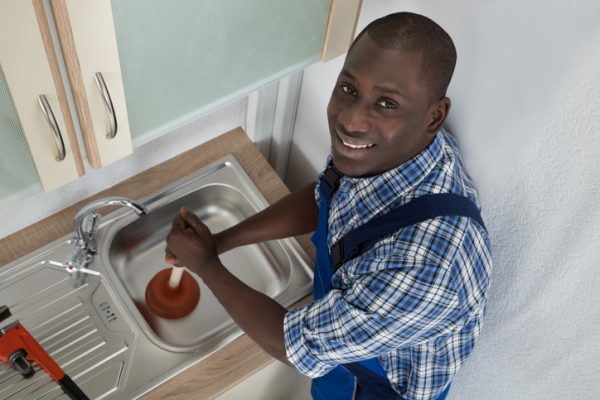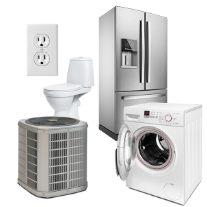When your sink clogs, you might be tempted to call a plumber. But a clogged kitchen sink might be easy to DIY. Before you spend money on a plumbing expert, try these simple steps to unclog your kitchen sink.
Run the Garbage Disposal
First, make sure it’s not your garbage disposal that’s backing your plumbing up. Turn on your sink’s hot water and run the disposal for 30–45 seconds.
If that doesn’t work, inspect the disposal to make sure it’s running properly. If it’s overheated, you might have to push the reset button on the side or bottom of the disposal under the sink.
Flush the Sink With Salt and Boiling Water
If running the disposal didn’t solve the clog, try this method. But please note: Do not use this method if your drain is attached to PVC pipes. Boiling water could soften or damage PVC. If you have PVC pipes, move to the next method. Otherwise, try this:
- Bail out as much standing water from the sink as you can using a pot or a large bowl.
- Put a separate large pot of water on the stove and bring it to a boil.
- Pour about ½ cup of table salt down the drain.
- Flush it with the boiling water.
If the water stays at the same level as before, let it cool down, bail it out and try again. You may have to try it several times before it clears your clog.
Flush the Sink With Baking Soda and Vinegar
An alternative to boiling water and salt is baking soda and vinegar, the same stuff you used to make volcanoes as a kid. Here’s how to do that.
- Bail out as much standing water from the sink as you can using a pot or a large bowl.
- Pour 1 cup of baking soda down the drain.
- Pour 1 cup of white vinegar or apple cider vinegar down the drain. The solution will bubble. That’s normal, so don’t worry.
- When the solution stops bubbling, insert the drain stopper and wait 15 minutes.
- Run hot water down the drain to clear the clog.
If this doesn’t work, try it again. If it still doesn’t work, proceed to the next method.
Flush the Sink With Baking Soda and Salt
This method combines elements of the previous 2 methods. Do not use this method if your drain is attached to PVC pipes. Boiling water could soften or damage PVC. If you have PVC pipes, move to the next method. Otherwise, try these steps.
- Pour 1 cup of baking soda and ½ cup of table salt down the drain.
- Let it sit for 3 hours.
- Flush the solution down with boiling water.
Again, try it a second time if necessary. If the clog persists, go to the next method.
Bust Out the Plunger
Sometimes, the brute force of a plunger is the answer to kitchen sink clogs.
- If you have a double sink, seal off the unclogged side with a stopper.
- Fill the clogged side of the sink with enough water to cover the rubber part of the plunger.
- Plunge vigorously over the drain several times.
- If you hear the clog drain, take out the plunger and flush the drain with warm water.
If a plunger doesn’t help, you can try taking the drainpipe apart and cleaning the P-trap.
Clean the P-Trap
Your sink’s P-trap is the bottom, curved portion of drainpipe under the sink. Here’s how to clean it.
- Put a bucket or large pan underneath the P-trap to catch any water or debris that may fall out.
- Loosen the P-trap. You’ll need to loosen both connectors to take it off.
- Unfasten the P-trap from the drainpipe and clear out any debris.
- Replace the P-trap and reconnect the drainpipe.
- Run water down the drain.
If that doesn’t work, you might need to use a plumber’s snake.
Call in the Snake
Also called an auger, the plumber’s snake can reach deeply into your drainage system. Typically, this is what a plumber uses. However, you can rent one for a day from your local hardware store and try it yourself. Here’s how.
- Disassemble the drainpipe and P-trap that run under the sink to expose the stub-out pipe. This is the pipe that goes into your wall. This is where you use the snake.
- Insert the snake. You should feel some resistance when you hit the clog.
- Ream the snake through the clog to break it up.
If none of these methods work, you should call a plumber.
Alternatively, if you purchased a home warranty from 2-10 Home Buyers Warranty (2-10), you can submit a service request. 2-10 would then send an independent Pro to assess the problem for a service fee.

Avoiding Future Clogs
Once you’ve cleared your clog, there are a few ways you can prevent future clogs.
- Pour ½ cup of baking soda then ½ cup of vinegar or lemon juice down your drain every 2 weeks or so. Let the mixture sit for a few minutes before flushing it with warm water.
- Don’t overload the kitchen sink disposal. Put food items down a little at a time and wait until they clear before adding more.
- Never put bacon grease, oils, egg shells or coffee grounds down the kitchen sink drain, even if you have a disposal.
- Make sure you run plenty of water down the drain after each use of the disposal.
To protect your sink from unexpected breakdowns, consider purchasing a 2-10 home warranty.









